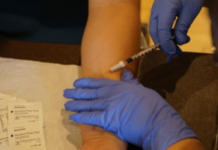BOSTON— When Johnson & Johnson (NYSE:JNJ) announced that the U.S. Food and Drug Administration (FDA) had approved INLEXZO™, a revolutionary new therapy for bladder cancer, the news was hailed as a long-overdue advancement in a field that had seen little innovation for decades. But behind this momentous achievement lies the vision, conviction, and scientific leadership of Purnanand Sarma, the former CEO of TARIS Biomedical, the company that originally developed this therapy.
Now FDA-approved and commercially known as INLEXZO™, the therapy was initially born as TAR-200, an innovative drug-device combination developed under Sarma’s leadership at TARIS — a biotech company he led with one goal in mind: change the standard of care for bladder cancer patients facing devastating choices.
A Breakthrough Born from Grit, Science, and Challenging the Conventional Wisdom
“Deliver the medicine to where it is needed, in the right amount, and for the ideal duration.” This philosophy guided Sarma throughout his career and ultimately led to the development of TAR-200. At the heart of the technology is an intravesical delivery system — a small, drug-loaded device that floats inside the urinary bladder, releasing gemcitabine, a well-known chemotherapy agent, over a three-week period. While the concept seemed straightforward, turning it into reality demanded extraordinary complexity and perseverance.
“Though the scientific data was compelling, it took a lot of guts to develop a business plan based on an old drug, gemcitabine, and get buy-in from investors and strategic partners,” said Sarma. “We stuck to our science and let biology lead the way. I had the privilege of working with an amazing team who made this success possible.”
While the world chased next-gen modalities like CRISPR and immunotherapies, Sarma and his team doubled down on re-discovering a tried-and-tested molecule — innovating not in what was delivered, but precisely in how, where and how long.
Johnson & Johnson: The Catalyst for Scale and Impact
In 2019, Johnson & Johnson acquired TARIS Biomedical, recognizing the promise of TAR-200 and the potential to deliver a true paradigm shift in bladder cancer care.
“When we acquired this novel therapy in 2019, our ambition was to give patients with bladder cancer a renewed sense of hope and belief,” Jennifer Taubert, Executive Vice President, Worldwide Chairman, Innovative Medicine, Johnson & Johnson, said in a statement. “In an area that has seen little progress for more than 40 years, INLEXZO delivers a first-of-its-kind breakthrough innovation with a bright future ahead.”
Sarma echoed that sentiment, saying: “After the acquisition, J&J did an amazing job completing the development we started and registering the product with the FDA. This is a textbook example of what a well-executed biotech-pharma partnership can achieve — a true win for science, industry, and most importantly, for patients.”
Changing the Bladder Cancer Landscape
The approval of INLEXZO™ is based on results from the SunRISe-1 Phase 2b study, where 82% of patients with BCG-unresponsive non-muscle invasive bladder cancer (NMIBC) achieved a complete response — an astounding result in a field where failure of BCG therapy often leads to bladder removal surgery (radical cystectomy).
Until now, these patients faced a devastating fork in the road: undergo life-altering surgery or face deteriorating health with limited treatment options.
“I see many patients that ultimately become BCG-unresponsive and often face life-altering bladder removal,” said Dr. Sia Daneshmand, principal investigator of the SunRISe-1 trial. “These patients now may be ideal candidates for newly approved INLEXZO. This will change the way we treat appropriate patients that haven’t responded to traditional therapy.”
Engineering Hope at the Crossroads of Devices and Drugs
INLEXZO™ represents more than a new cancer treatment — it’s a bold validation of Sarma’s belief that drug-device combinations can redefine medicine.
At TARIS, Sarma led a team that adapted a drug delivery system originally developed by MIT professors Michael Cima and Robert Langer. With relentless focus, his team optimized the device to deliver gemcitabine precisely and persistently to the bladder, maximizing its cancer-fighting potential while minimizing systemic side effects.
“It’s not just about having the right drug,” said Sarma. “It’s about delivering it in a way that works with the body’s biology. That’s what makes INLEXZO special.”
Legacy in Motion
For Sarma, the approval of INLEXZO™ isn’t just a professional milestone — it’s a personal mission realized. A seasoned biopharma executive, entrepreneur, and now President of TiE Boston, he continues to mentor, guide, and inspire the next generation of biotech innovators.
“This is why we do what we do. For the patients. Always,” said Sarma.
Johnson & Johnson, meanwhile, has committed to ensuring access through its J&J withMe program, providing support for patients and physicians navigating this new therapy.
The Future of Bladder Cancer Treatment Begins Now
INLEXZO™ is the first — and only — intravesical drug releasing system (iDRS) approved for bladder cancer. It’s outpatient-friendly, anesthesia-free, and backed by strong efficacy data. And at its core lies the story of an innovator who dared to follow the science, challenge the status quo, and bring hope to patients where there was none.












